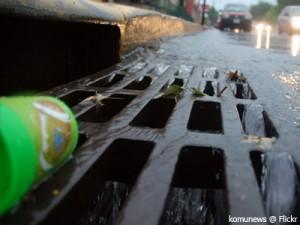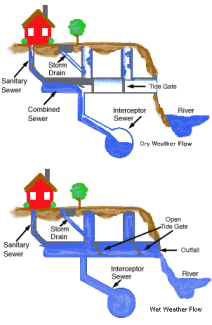Why is it a Problem?
How exactly does stormwater pollute? Here are a few ways:

It contributes sediment to water bodies, which can make it difficult or impossible for aquatic plants to grow. This can destroy aquatic habitats for fish and aquatic life.
It contributes excess nutrients (for example, phosphorus and nitrogen) to water bodies,which can cause algae blooms. Algae blooms remove oxygen from the water, which in turn, kills fish and other aquatic life.
It contributes bacteria and other pathogens to water bodies, which can wash into swimming areas and create health hazards. This is usually what has happened which beaches are closed.
It contributes debris to our water bodies.Litter such as plastic bags, six-pack rings, bottles, and cigarette butts wash into lakes, streams, rivers, and the ocean, and can choke or suffocate aquatic life such as ducks, fish, turtles, and birds.
It contributes household hazardous wastes such as insecticides, pesticides, paint, solvents, used motor oil, and other auto fluids to our water bodies. People (and even pets and other animals) can become sick from eating diseased fish and shellfish or ingesting polluted water.
It affects drinking water sources. This, in turn, can affect human health and increase drinking water treatment costs.
Over the past 30 years, Rhode Islanders have invested millions of dollars to upgrade municipal wastewater treatment facilities, pre-treat industrial wastes, and eliminate sewage discharges from boats. We’ve made great progress in dealing with these obvious pollution sources. As a result, many of our rivers and coastal waters are now healthier than ever. But continued monitoring is showing that stormwater pollution is a more serious problem than we once thought. According to the U.S. Environmental Protection Agency, stormwater pollution is now the major water quality problem in the United States.
Many people assume that stormwater flows down storm drains and then to a treatment facility. Unfortunately, that is almost never the case. Stormwater either flows directly into local waters or down storm drains, which channel it into local water bodies. The polluted runoff closes swimming beaches and fishing grounds, threatens water resources, harms natural areas, and contributes to flooding.
A 2008 URI Cooperative Extension survey shows that most Rhode Islanders associate wet weather pollution with Combined Sewer Overflows (CSOs). This is a problem only in older cities such as Providence and Newport where wastewater sewers and storm drains were connected when first built. These sewers overflow with heavy rain, releasing a mix of stormwater and raw sewage that shuts down shellfishing beds. Massive retrofits of combined sewers, now underway deep beneath the streets of Providence, will eliminate 40 percent of overflows with completion of the first phase. The main benefits are expected in the upper Bay, where shellfish closures will be reduced by 50 percent. Meanwhile, stormwater pollution is a statewide problem, affecting every Rhode Island community.
What Is A CSO And Why Isn’t It The Solution?
When the topic of stormwater surfaces, many people think of CSOs, Combined Sewer Overflows. Before we discuss that issue, we need to sort out the difference between storm drains and sanitary sewers:

Storm Drains
When rain water flows across pavement and down a storm drain, that water is almost always piped directly to the nearest stream, river, or bay. That water almost never goes to a treatment facility. As the graphic illustrates, most storm drains simply collect rain water and channel it away to prevent flooding, carrying polluted runoff to local water resources.
Sanitary Sewers
Sanitary sewers carry wastewater or “sewage” from homes and businesses through an entirely separate piping network below city streets. Manhole covers allow access for maintenance, but there are no open drains or grates. This wastewater flows to a municipal wastewater treatment facility where it is treated, and that treated effluent is discharged to local rivers and the Bay. Today, businesses are required to pre-treat their wastes before discharging into the system. And many wastewater treatment facilities are being upgraded to improve the quality of wastewater discharged to local waters.
Combined Sewers
The exception to the above are combined sewers, where the storm drain and sanitary sewers have a connection. These are a problem in older urban areas such as Providence and Newport, where the stormwater and wastewater lines were originally interconnected. As the graphic illustrates, in dry weather, both the stormwater and the sanitary waste go to a treatment facility. With small storms, the system has enough capacity to treat both the wastewater flow and the additional stormwater. But in larger storms, the pipe overflows, resulting in discharge of mixed stormwater and untreated sewage directly into rivers and the Bay. When a “combined sewer overflow” happens, parts of Narragansett Bay are temporarily closed to shellfishing.
Currently, a CSO retrofit project is underway in upper Narragansett Bay to correct this problem; it involves building subsurface tunnels to store and gradually treat the mixed stormwater and wastewater at the wastewater treatment facility. It is estimated that the project will reduce overflows by 40% after the completion of the first phase, and by 98% at the project’s completion.
However, because most stormwater pollution is not channeled through a combined sewer, we have to tackle this problem through other means!
